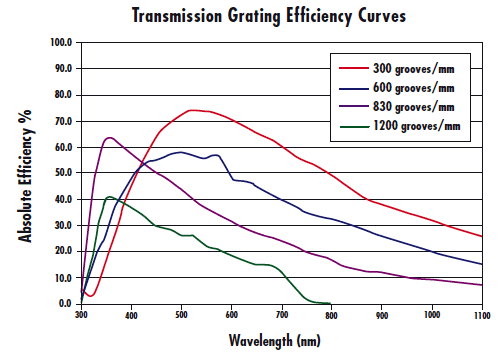
Transmission Gratings are designed to disperse incident light at specific angles. Angular dispersion is a function of angle of incidence and groove spacing. Dispersion increases as angle of incidence increases or as groove spacing decreases. Coarse groove spacing maintains high efficiency while fine groove spacing reduces transmission at long wavelengths resulting in low efficiency. Transmission Gratings are offered in 3 dimensions with varying groove densities.
Transmission Gratings offer low polarization sensitivity as opposed to reflection gratings because incident light is not reflected by a mirror coating such as aluminum. Since light is transmitted through the grating, transmission gratings can be used in compact, in-line configurations. They are ideal for use in monochromators and spectrometers.
Transmission Gratings are manufactured in the same way as ruled reflection gratings in which a replica of a master grating is created by duplicating its grooved surface with a thin, vacuum deposition-coated layer, except they have no reflective overcoat. Uncoated transmission gratings provide high efficiency over a long wavelength range while Anti-Reflection (AR) coated gratings increase performance at a specific wavelength. AR coated versions are available upon request; please contact our Applications Engineering Department.
Handling Gratings: Gratings require special handling, making them prone to fingerprints and aerosols. Gratings should only be handled by the edges. Before attempting to clean a grating, please contact us.

1-800-363-1992
or view regional numbers
QUOTE TOOL
enter stock numbers to begin
Copyright 2025, Edmund Optics Singapore Pte. Ltd, 18 Woodlands Loop #04-00, Singapore 738100
California Consumer Privacy Acts (CCPA): Do Not Sell or Share My Personal Information
California Transparency in Supply Chains Act